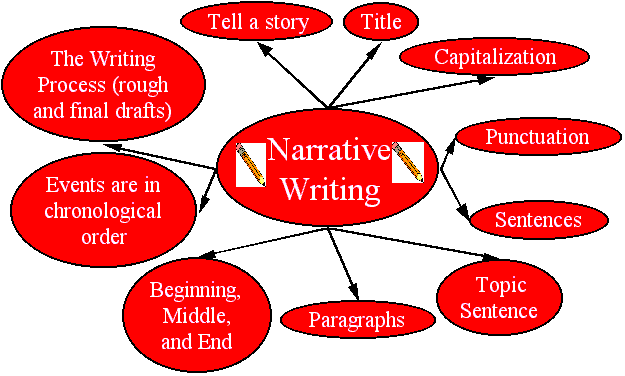| CONCEPT MAPPING
There are a number of methods and
processes that might be useful in helping your design of a digital media
project e.g. -- brainstorming, brainwriting, nominal group techniques,
focus groups, affinity mapping, Delphi techniques. Here is a concept map illustrating the concept of "Writing a Narrative". Note the nodes (other concepts e.g. the concept of having a beginning, middle and end) associated with the topic radiating from the centre. Each of these concepts have ideas associated with them to enable their implementation.
Although concept mapping is a general method, it is particularly useful for helping designers develop and detail ideas for digital media projects. And, it is especially valuable when designers want to involve relevant stakeholder groups in the act of creating the project. Concept mapping is used for many purposes -- strategic planning, product development, market analysis, decision making. So what is concept mapping? Essentially, concept mapping is a structured process, focused on a topic or projectc, involving input from one or more participants, that produces an interpretable pictorial view (concept map) of their ideas and concepts and how these are interrelated. Concept mapping helps people to think more effectively as a group without losing their individuality. It helps groups to manage the complexity of their ideas without trivializing them or losing detail.
A concept mapping process involves six steps. The first step is the Preparation Step. There are three things done here. The facilitator of the mapping process works with the initiator(s) (i.e., whoever requests the process initially) to identify who the participants will be. Second, the initiator works with the stakeholders to develop the focus for the project. For instance, the group might decide to focus on the use of Flash animations. Or, they might choose to map all of the ideas they might expect to implement. Finally, the group decides on an appropriate schedule for the mapping. In the Ideas Generation Step the project team develop ideas that address the project. A wide variety of methods can be used to accomplish this including traditional brainstorming, brainwriting, nominal group techniques, focus groups, qualitative text analysis, and so on. In the Ideas Structuring Step the participants do two things. First, each participant sorts the ideas into piles of similar ones. Most times they do this by sorting a deck of cards that has one idea on each card. But they can also do this directly on a computer by dragging the ideas into piles that they create. They can have as few or as many piles as they want. Each participant names each pile with a short descriptive label. Second, each participant rates each of the ideas on some scale. Usually the ideas are rated on a 1-to-5 scale for their relative importance, where a 1 means the statement is relatively unimportant compared to all the rest, a 3 means that it is moderately important, and a 5 means that it is extremely important. The Draw Maps Step -- this is the process of taking the sorted ideas and "representing" them in map form. The project name or initial concept is drawn in the centre of a page and idea clusters from the structuring step are drawn as nodes radiating out from the centre. In the fifth step -- The Interpretation Step -- the facilitator works with the stakeholder group to help them develop their own labels and interpretations for the various maps. Finally, the Utilization Step involves using the maps to help address the original focus. On the program side, the maps can be used as a visual framework for the project. on the outcome side, they can be used as the basis for developing measures and displaying results.
Benefits from Concept Mapping. Mapping may be seen as a type of brainstorming. Both Mapping and brainstorming may be used to encourage the generation of new material, such as different interpretations and viewpoints: however, Mapping relies less on intentionally random input, whereas, during brainstorming, one may try to think up wild, zany, off-the-wall ideas and connections. Brainstorming attempts to encourage highly divergent "lateral" thinking, whereas Mapping, by its structure, provides opportunity for convergent thinking, fitting ideas together, as well as thinking up new ideas, since it requires all ideas to be connected to the centre, and possibly to one another. Paradoxically, the results of brainstorming usually appear on paper as lists or grids -- both unavoidably linear structures: top to bottom, left to right. Mapping is less constrictive -- no idea takes precedence arbitrarily (eg. by being at the "top" of the list). Here are some advantages of Mapping, which will become more apparent to you after you have practiced this technique a few times:
|

